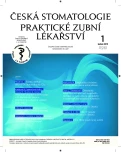-
Medical journals
- Career
The Loss of First Permanent Molar in Young Patients
Authors: M. Koťová; J. Hovorka
Authors‘ workplace: Stomatologická klinika 3. LF UK a FNKV, Praha
Published in: Česká stomatologie / Praktické zubní lékařství, ročník 113, 2013, 1, s. 14-19
Category: Case Report
Věnováno prof. MUDr. Janě Duškové, DrSc., MBA, k životnímu jubileu
Overview
Introduction:
The loss of first permanent molar significantly reduces the biological quality of the dentition. In addition to prosthetic rehabilitation in indicated cases, we can also take advantage of orthodontic space closure with mesial shift of the second and third permanent molar. The result of this solution may not always be satisfactory. As an unindicated orthodontic space closure post extraction leads to worsening of space ratios in the affected part of the dentition and causes disorder in relationship between antagonists. To restore good functional and morphological harmony of the dental arches it is then necessary to compen-sate the occlusal relationships with additional orthodontic extractions and demanding orthodontic therapy. Therefore it is necessary, especially in young patients who lost first permanent molar and orthodontic closure seem an easy and good solution, to carefully analyze dental status with the planed result of the orthodontic therapy, including diagnostic dental reconstruction models (diagnostic set-up).Aim:
The authors summarize the timing of the extraction, when needed, of first permanent molars in children and adolescents, where final prosthetic rehabilitation is not indicated due to their age. They emphasise the difficulties of the orthodontic gap closure after the extraction of permanent molar.Observation:
The treatment of two patients at the age 8 and 13 years where first permanent molar were extracted is presented. The space was closed by means of orthodontic tooth movement.
The first case is eight years old girl, where first permanent molars were extracted in the lower jaw in mixed dentition. Patient had a significant lack of space in both dental arches. Plan of extractions for orthodontic reasons was modified according to biological factor of the dentition. When extraction of first permanent molars is indicated in the mixed dentition, attention to the eruption of the second premolars must be paid.
The second case is thirteen years old boy who lost the right lower first permanent molar while all permanent teeth already erupted. Orthodontic space closure was achieved by mesialisation of the second molar, unfortunately the occlusal condition worsened.Conclusion:
Orthodontic space closure after extraction of first permanent molar is not always indicated and requires careful treatment plan.Key words:
loss of the first permanent molar – child – adolescent – orthodontic post extraction space closure
Sources
1. Broukal, Z., et al.: Analýza orálního zdraví vybraných věkových skupin České republiky 2003. Souhrnná zpráva. Výzkumný ústav stomatologický a Ústav zdravotnických informací a statistiky ČR, 2004.
2. Hotz, R. P., et al.: Zahnmedizin bei Kindern und Jugendlichen. Stuttgart, Georg Thieme Verlag, 1986.
3. Kamínek, M., Štefková, M.: Ortodoncie II. Výukové texty. Olomouc, LF UP, 1991.
4. Merglová, V., Ivančaková, R.: Zubní kaz a jeho prevence v časném dětském věku. Praha, Česká stomatologická komora, 2009.
5. Vadiakas, G.: Case definition, aetiology and risk assessment of early childhood caries (ECC): a revised rewiew. Eur. Arch. Paediatr. Dent., roč. 9, 2008, č. 3, s. 114–125.
6. Weber, T.: Memorix Zahnmedizin. 3.,vollständig überarbeitete und erweiterte Auflage. Stuttgart, New York, Georg Thieme Verlag, 2010.
Labels
Maxillofacial surgery Orthodontics Dental medicine
Article was published inCzech Dental Journal

2013 Issue 1-
All articles in this issue
- Association between Oral Health Indicators in 13- to 15-years-old Children of ELSPAC Group Brno and Parental Educational Level
- The Loss of First Permanent Molar in Young Patients
- Is there a Possibility of Early Diagnosis of Acromegaly by General Practicioner?
- Diagnosis and Treatment Possibilities of Oral Lichen Planus
- Surgical Completion of Primarily Nonsurgical Stomatologic Operation Commenced Wearing Nonsterile Disposable Gloves
- Czech Dental Journal
- Journal archive
- Current issue
- Online only
- About the journal
Most read in this issue- Diagnosis and Treatment Possibilities of Oral Lichen Planus
- The Loss of First Permanent Molar in Young Patients
- Is there a Possibility of Early Diagnosis of Acromegaly by General Practicioner?
- Association between Oral Health Indicators in 13- to 15-years-old Children of ELSPAC Group Brno and Parental Educational Level
Login#ADS_BOTTOM_SCRIPTS#Forgotten passwordEnter the email address that you registered with. We will send you instructions on how to set a new password.
- Career

